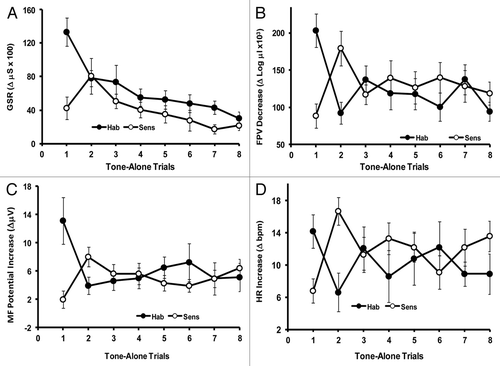Figures & data
Figure 1. (A) The GSR consists of the difference function derived by subtracting the palmar skin conductance level (SCL) immediately before stimulus onset from the highest palmar skin conductance level (SCL) reached within 10 sec after stimulus onset for each subject on each trial. The SCL is measured in micro-Siemens (µS). This is a well established method for recording the GSR.Citation4,Citation26,Citation30 (Habituaters: n = 40; Sensitizers: n = 6). The standard error of the mean (SEM) is shown on each trial for all four effector systems. (B) The finger pulse volume decrease (FPV) to a stimulus is measured as the difference between the log of the mean micro-liters per stroke of the two pulses just preceding the stimulus minus the log of the mean micro-liters per stroke of the smallest two consecutive pulse waves occurring within 30 sec after the stimulus onset. This difference is a measure of the degree of vasoconstriction for each subject on each trial.Citation30 (Habituaters: n = 21; Sensitizers: n = 20). (C) The muscle frontalis (forehead) potential increase (MF) consists of the difference in magnitude between the average height of several consecutive potentials just prior to the stimulus onset and the average height of the largest consecutive potentials occurring within 30 sec following the stimulus. This difference, post-stimulus magnitude minus pre-stimulus magnitude in micro-volts (ΔμV), constitutes the response measure for each subject on each trial.Citation30 (Habituaters: n = 18. Sensitizers n = 21). (D) The heart rate increase (HR) to the stimulus is measured as the difference between the highest rate (shortest R-R interval within 30 sec after stimulus onset) and the immediate pre-stimulus rate for each subject on each trial.Citation30 (Habituaters: n = 14; Sensitizers: n = 28).
